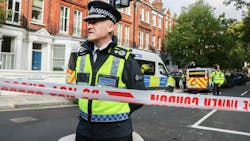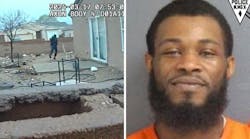LONDON — An Islamic State group claimed responsibility for the attack that rocked London on Friday — the fifth this year — and U.K. officials raised the terror threat to critical, meaning another attack is expected.
The attack sent panicked commuters running for cover during the morning rush hour and sparked a massive manhunt for the perpetrator, who remained at large.
Authorities said the incident was caused by an improvised explosive device that had been left inside a bucket in a supermarket cooler bag on a busy subway car.
Photos on social media showed a white bucket on fire inside the train.
The train was entering Parsons Green station in leafy southwest London, heading toward central London, when the bomb burst into flames around 8:20 a.m. local time. It reportedly had a timer attached, but it was not immediately clear whether it detonated as planned or earlier than intended.
Twenty-nine people were injured, most suffering flash burns, but no one was killed — unlike the other terror attacks this year that left dozens killed and scores more hurt. Police immediately launched a manhunt, but the individual who caused the blast was still at large later in the day Friday.
Prime Minister Theresa May summoned a meeting of the government’s emergency COBRA committee and described the attack as “cowardly.”
At first she said the nationwide terror threat level would remain at “severe,” and that it was under review.
Later May announced that the level would be raised to “critical,” and that “a further attack may be imminent.”
“The joint terrorism and analysis center, the independent organization responsible for setting the threat level on the basis of available intelligence, has now decided to raise it from severe to critical,” May announced.
May last raised it to “critical” in the wake of the Manchester Arena blast in May at the conclusion of an Ariana Grande pop concert.
U.S. President Donald Trump took to Twitter a few hours after the incident to condemn the attack while also appearing to suggest that officials were aware of the identity or identities of the people behind it.
“Another attack in London by a loser terrorist. These are sick and demented people who were in the sights of Scotland Yard. Must be proactive!” he said in his first tweet.
He also renewed his call for a tougher travel ban in the United States.
“The travel ban into the United States should be far larger, tougher and more specific - but stupidly, that would not be politically correct!”
When questioned about those comments, May responded: “I never think it’s helpful for anybody to speculate on what is an ongoing investigation.”
Metropolitan Police Assistant Commissioner Mark Rowley said the public would see a heightened police presence at transport hubs and urged anyone with images of the incident, or knowledge of the attack, to contact authorities.
He said the public should remain alert but should not be alarmed.
The mayor of London, Sadiq Khan, said the attack was an attempt by “evil and cowardly” individuals to disrupt the city’s way of life, adding that the capital would never be defeated by terrorism.
He also called for more police resources in London, saying he was unapologetic for using this incident to again spotlight the issue of budget cuts.
“Since 2010, we’ve lost hundreds of millions of pounds from the police budget. We’ve had to reduce police staff. We’ve had to sell off police stations,” he told Sky News.
“It’s simply not possible for a global city like London to carry on keeping our citizens, visitors and businesses safe if the government carries on making the cuts they’ve been making.”
Since 2005, Britain has been the target of terrorist attacks more than half a dozen times.
London’s subway system has also been a target in the past, such as in 2005 when suicide bombers attacked three underground subway trains and a double-decker bus — killing 52 people and injuring more than 700.
But experts said this year has been particularly violent, with terrorists using easy-to-access items, such as vehicles or knives, to carry out attacks.
In early June, six people were killed when a van rammed into pedestrians on London Bridge and assailants fled on foot, stabbing people. Later that month in June, a vehicle plowed into a group of Muslim worshippers in Finsbury Park, killing one person and injuring others.
In May, 22 people were killed at a pop concert when a suicide bomber detonated a bomb at the end of the show. And a few weeks before that in March, six people died when a terrorist drove his car into people on Westminster Bridge, near the Houses of Parliament.
While authorities continue to search for the perpetrators and have not said whether this was an attack inspired by Islamic State, Amaq, an agency affiliated with Islamic State, quoted a security source saying that a “security squad” had conducted the attack.
Islamic State has repeatedly called on its followers to carry out attacks on trains. Last month an Islamic State activist offered bomb-making tips on a pro-Islamic State telegram channel, according to the nonprofit Middle East Media Research Institute.
Experts said Friday’s incident suggests it was an attack that took considerable planning.
“This was an attack on London’s transportation infrastructure and it doesn’t seem to be an opportunity attack — someone had the time to gather resources and build the device,” said Erroll Southers, director of the University of Southern California’s Homegrown Violent Extremism Studies.
“Trains are open and a vulnerable system. It is a soft target. It is likely to encourage more copycat attacks and it’s also going to require an extraordinary level of security to deter these things from happening,” Southers said.
Outside a Paris subway station in France on Friday, a man wielding a knife attacked a French soldier. The attacker was arrested and did not cause any injuries to the soldier. French counterterrorism officials are now investigating.
Boyle, a Times special correspondent, reported from London. Times staff writer Etehad reported from Los Angeles.
Copyright 2017 Los Angeles Times
Tribune News Service



